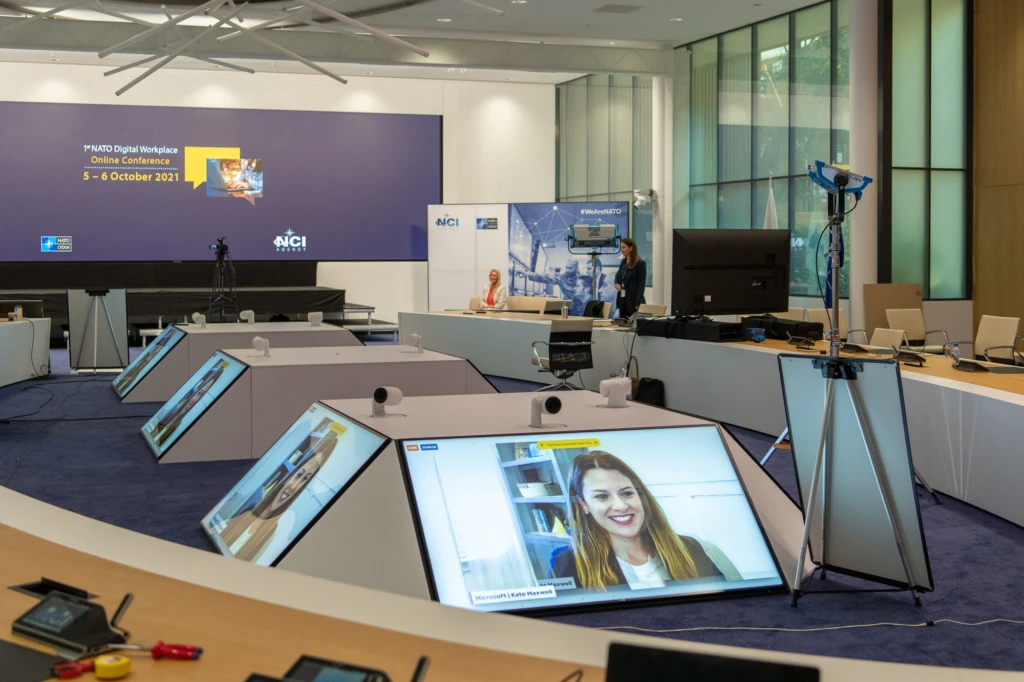
A digital workplace for a modern defense ecosystem

I recently participated in the first-ever NATO Digital Workplace Conference, where we spent two days discussing the future of defense work. It was a fantastic event, and I was honored to keynote a session on “A digital workplace for a modern defense ecosystem.” To keep the conversation going, I would like to share some highlights with you, and I look forward to hearing your thoughts.
The great workplace shift
The past eighteen months have seen a dramatic shift in where and how people work, across all industries—defense and intelligence included. The global pandemic accelerated digital transformation and forced defense organizations to rethink productivity, collaboration, training, and employee well-being. Many of us have now experienced the benefits of the hybrid work model, and we are seeing it work for defense organizations around the world.
Three truths have emerged during this great workplace shift:
- Flexible, hybrid work is here to stay.
- Employee expectations and the talent landscape have fundamentally shifted.
- Culture and technology are the key enablers of a future defense workplace.
Truth No. 1: Hybrid work is here to stay.
I’d like to share some statistics from the 2021 Work Trend Index, our annual, independent study of more than 30,000 people across 31 countries in both commercial and Public Sector industries.
The data shows the following:
- 73 percent of employees want flexible remote work options to stay.
- 67 percent of employees want more in-person work or collaboration post-pandemic.
What does this data mean? It means that people are now fully embracing the “hybrid paradox”—wanting both the flexibility to work from anywhere, while also craving in-person connection opportunities with colleagues. There is no “one size fits all” approach to hybrid work, and that’s the beauty of it. It must be flexible and tailorable to meet the needs of both the organization and the individuals within it.
We have been working to enable hybrid environments for global defense clients, with two excellent examples from the United States and Australia:
- The US Department of Defense’s “Commercial Virtual Remote” hybrid environment, or “CVR,” was built on the Microsoft Teams platform and stood up in less than one month at the start of COVID-19 hosting more than four million defense employees in their daily work and collaboration activities.
- Similarly, the Australian Department of Defence’s “Virtual Environment for Remote Access,” or “VERA,” was stood up to help Australian Defense Forces move from 2,000 remote workers per day to more than 20,000, and it was up and running in less than eleven weeks’ time from conception to production.
These hybrid environments are critical to a modern defense posture, and I am happy to see defense forces adopting them around the world. Hybrid environments for defense are here to stay, and Microsoft is here to help.
Truth No. 2: Employee expectations have fundamentally shifted.
Here is a statistic I find both fascinating and alarming: In the month of August 2021, more Americans quit their jobs than in any other month on record. Ever. Drilling down across all sectors and occupations, now four in ten employees say they are considering leaving their current place of work. This is not just an American problem, but a global one. And this impacts all industries, including global defense.
So what is driving this “Great Resignation,” and why is it happening now, more than eighteen months into the pandemic?
We are in the midst of a fundamental shift in the relationship between employees and employers. Many employees have experienced the benefits of a hybrid work model due to the pandemic, and their workplace expectations have changed as a result. If employers now ask people to return to a traditional, in-person work model, employees realize they can say “no” and find flexibility and a better work culture elsewhere.
To reinforce that point, a recent Bloomberg survey found that 39 percent of the existing workforce will consider quitting their jobs if their employer does not offer a hybrid work option going forward. Breaking that down by generation, that statistic jumps to nearly 50 percent among Gen Z and Millennial workers—who comprise about half of the total workforce and growing.
This has huge implications for the defense ecosystem. Our industry already faces a shortage of cleared talent, particularly in STEM fields. Not to mention, we compete with other industries for the best and brightest candidates. Our defense workplace must meet the needs and expectations of an evolving workforce, or we risk losing that talent and exacerbating the defense talent crisis. It is a global security imperative that we maintain a healthy and diverse defense workforce, and a hybrid work model is one way to do that.
On the flip side, talent is everywhere in a hybrid work world. Unclassified work can now be performed from most anywhere in the world, and that is democratizing access to opportunity for both employees and employers. This is a huge opportunity for the defense ecosystem, in part due to the hybrid model where location is no longer a factor. We as a defense ecosystem should take advantage of this to help solve the defense talent gap. Let’s use the hybrid work model to our advantage.
Now, pivoting to the people experience, it’s important to note that the workforce is tired. People are tired. 85 percent of workers surveyed say mental wellbeing has declined during the pandemic, while 56 percent report that job demands have increased over the same period. That’s a bad combination.
The past eighteen months have been grueling in many ways. People are rethinking their values, how much stress they are willing to put up with, their work/life balance, and where and how they spend their time. The rapid adoption of a hybrid work model has been accompanied by an increase in “digital intensity” for the average worker’s day—so we must be thoughtful about how we manage that, particularly in high-stakes, high-stress work environments, such as global defense.
It is more important now than ever that we consider the defense employee experience in this new hybrid work environment. If the lines between home and the defense workplace blur, how can we help employees with productivity while also giving them a great work experience where they feel safe, valued, empowered, and have a sense of belonging – no matter where they work?
The answer: we need to create durable changes to the defense workplace itself, and the way in which we work, to improve wellbeing. People are struggling, and employers and the hybrid work environment can help. This is something we take very seriously at Microsoft, and we believe real transformation happens at the intersection of people, technology, and culture.
Which leads us to the third truth:
Truth No. 3: Culture and technology are key enablers of a future defense workplace.
The future defense workplace is not just a technology story. We need to build this workplace at the intersection of culture and technology to truly get it right.
For the defense workforce to thrive in this new hybrid environment, we need to build a culture of trust and flexibility so employees can embrace the work style that is best for them, and feel supported in those choices. We must put the right digital tools in their hands so they can be productive, collaborative, innovative, and secure no matter where or how they choose to work.
Redefining the defense workplace
In closing, this global defense ecosystem is at an inflection point.
We have an amazing opportunity right now to define the digital workplace of a future-ready allied defense ecosystem. That definition needs to include a combination of people, places, processes, technology, and culture if we are to get it right. We must put the experience of the defense worker at the core, and seek to build a flexible, hybrid defense workplace that serves the needs of a diverse and evolving coalition.
Related to this, it is imperative that we address digital overload in the hybrid work model. Keep an eye out for my next industry blog, where I will share some tools and tips to help address this challenge for the defense industry, and the defense worker. In December, we will be hosting our next Microsoft Industry Digital Forum on this very subject, and we look forward to taking your questions and hearing your thoughts.
Microsoft is proud to be a trusted mission partner to NATO and allied defense organizations around the world, and we are honored to serve the needs of this global defense community both now and in the years ahead.
To learn more about how Microsoft is helping defense and intelligence organizations around the world, please visit Microsoft Defense and Intelligence.




